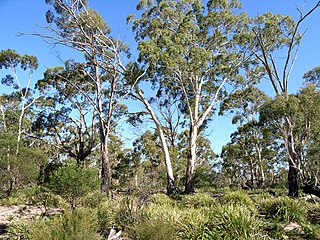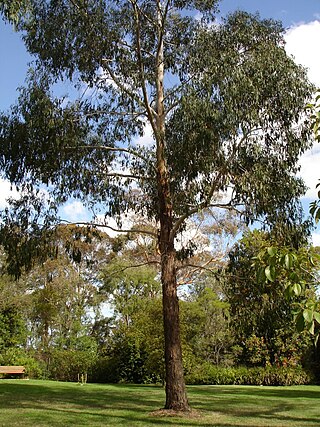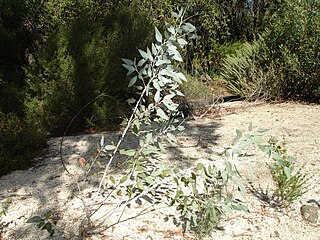
Eucalyptus viminalis, commonly known as the manna gum, white gum or ribbon gum, is a species of small to very tall tree that is endemic to south-eastern Australia. It has smooth bark, sometimes with rough bark near the base, lance-shaped to curved adult leaves, flower buds in groups of three or seven, white flowers and cup-shaped or hemispherical fruit.

Eucalyptus ovata, commonly known as swamp gum or black gum, is a small to medium-sized tree species that is endemic to south-eastern Australia. It has mostly smooth bark, glossy green, lance-shaped to egg-shaped adult leaves, green flower buds in groups of seven, white flowers and conical to bell-shaped fruit.

Eucalyptus lansdowneana, commonly known as the crimson mallee or the red-flowered mallee box, is a species of slender stemmed, straggly mallee that is endemic to a restricted area of South Australia. It has rough, fibrous or flaky bark at the base, smooth, grey over creamy-white bark, lance-shaped adult leaves, flower buds in groups of seven, crimson flowers and barrel-shaped fruit.

Eucalyptus cretata, commonly known as Darke Peak mallee or chalky mallee, is a species of mallee or, rarely, a small, straggly tree and is endemic to a restricted part of South Australia. It has smooth whitish and grey bark, lance-shaped adult leaves, glaucous flower buds in groups of seven, white flowers and cup-shaped to barrel-shaped or conical fruit.

Eucalyptus baxteri, commonly known as brown stringybark, is a medium-sized tree that is endemic to the south-east of mainland Australia. It has rough, stringy bark to the thinnest branches, lance-shaped or curved adult leaves, green to yellow flower buds in groups of between nine and fifteen, and cup-shaped or hemispherical fruit.
Eucalyptus elaeophloia, commonly known as Nunniong gum or olive mallee, is a species of tree or mallee that is endemic to a restricted area in Victoria. It has mostly smooth greenish to greyish bark, glossy green, lance-shaped adult leaves, flower buds in groups of three, white flowers and conical or hemispherical fruit.

Eucalyptus fasciculosa, commonly known as pink gum, hill gum or scrub gum, is a species of small tree that is endemic to southern Australia. It has mostly smooth, light grey to pinkish bark, lance-shaped adult leaves, flower buds in groups of seven, white flowers and conical to barrel-shaped fruit.

Eucalyptus albopurpurea, commonly known as the purple-flowered mallee box or Port Lincoln mallee, is a mallee or sometimes a tree that is endemic to South Australia. It has loose, fibrous grey-brown bark on the lower park of the trunk and smooth grey bark that is shed in strips on its upper parts. The leaves are lance-shaped to egg-shaped, the flower buds are spindle-shaped to club-shaped and the flowers are white, pink, mauve or purple. Flowering can occur in most months and the fruit are cup-shaped or barrel-shaped capsules.

Eucalyptus aquatica, commonly known as broad-leaved sally, or mountain swamp gum is a tree or mallee that is endemic to a small area of New South Wales in eastern Australia. It has smooth, greyish bark, dull bluish green adult leaves, flower buds arranged in groups of seven, white flowers and conical or hemispherical fruit. It grows in swamps and other places with poor drainage.

Eucalyptus gillenii, commonly known as the mallee red gum, Mt Gillen mallee or Mt Lindsay mallee, is a species of mallee that is endemic to inland Australia. It has smooth, mottled bark, linear to narrow lance-shaped adult leaves, flower buds in groups of seven or nine, white flowers and hemispherical or cup-shaped fruit.
Eucalyptus gypsophila, also known as the kopi mallee, is a species of mallee that is native to Western Australia and South Australia. It has rough, flaky bark on the lower part of the trunk, smooth light grey bark above, lance-shaped adult leaves, flower buds mostly in groups of between seven and eleven, creamy white flowers and conical to cylindrical fruit.

Eucalyptus phenax, commonly known as green dumosa mallee or white mallee, is a species of mallee that is endemic to southern Australia. It has smooth bark, lance-shaped adult leaves, flower buds in groups of seven or nine, white flowers and cup-shaped to cylindrical fruit.

Eucalyptus sparsa, commonly known as the northern ranges box, is a species of mallee that is endemic to inland Australia, near the border between the Northern Territory, South Australia and Western Australia border. It has smooth pale grey and brown bark, often with rough bark on the base of larger trunks, lance-shaped adult leaves, flower buds usually in groups of seven, white flowers and shortened spherical to conical fruit.

Eucalyptus flindersii, commonly known as the South Australian grey mallee, mallee red gum, or grey mallee, is a species of mallee that is endemic to South Australia. It usually has smooth, pinkish grey bark, lance-shaped to curved adult leaves, flower buds in groups of three or seven and conical or hemispherical fruit with the valves protruding.
Eucalyptus percostata, commonly known as the rib-capped mallee or Devils peak mallee, is a species of mallee that is endemic to South Australia. It has smooth bark, lance-shaped adult leaves, flower buds in groups of seven, creamy white flowers and cup-shaped to conical fruit. It is only known from a few locations in the Flinders Ranges.

Eucalyptus calcareana, commonly known as the Nundroo mallee or Nundroo gum, is a mallee or a small tree that is endemic to the south coast of Australia. It has smooth, greyish or cream-coloured bark, lance-shaped or curved adult leaves, flower buds in groups of seven or nine, creamy-white flowers and cup-shaped to conical fruit.

Eucalyptus cyanophylla, commonly known as the Murraylands mallee, blue-leaved mallee or ghost mallee, is a species of mallee that is endemic to southern Australia. It has mostly smooth bark, greyish blue, lance-shaped or curved adult leaves, flower buds in groups of seven, white flowers and conical, cup-shaped or barrel-shaped fruit.

Eucalyptus arcana, commonly known as the Mallee manna gum or Carpenter Rocks gum is a mallee that is endemic to South Australia. It has rough bark from the base of the trunk to the thinnest branches, lance-shaped, sometimes curved leaves, flower buds in groups of seven, white flowers and hemispherical fruit. It is only known from a single population near Carpenter Rocks.
Eucalyptus chartaboma, commonly known as paperbark gum, is a eucalypt that is endemic to Queensland. It is a medium-sized tree with soft, papery, fibrous bark on the lower trunk, smooth white to pale cream-coloured bark above, lance-shaped adult leaves, flower buds in groups of seven, orange-coloured flowers and oval to urn-shaped fruit. The flower buds and fruit have distinct ribs along their sides.

Eucalyptus cosmophylla, commonly known as cup gum, bog gum or scrub gum, is a species of small tree or mallee that is endemic to South Australia. It usually has smooth bark and lance-shaped adult leaves, flower buds arranged in groups of three, white flowers and cup-shaped, cylindrical or hemispherical fruit.
















